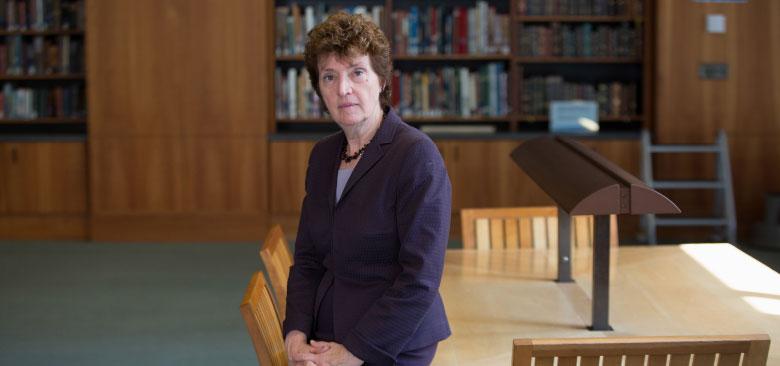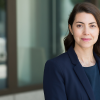
Barbara Koenig (photos by Elisabeth Fall)
Making Sense of California’s End of Life Option Act
When Governor Jerry Brown signed California’s End of Life Option Act (EOLOA) into law in 2015, Barbara Koenig believed it presented the state with “a bioethics emergency.”
A professor in UC San Francisco School of Nursing’s Institute for Health & Aging and director of the UCSF bioethics program, Koenig was among those who convened a statewide conference where stakeholders could begin to hash out their response to the controversial new law, before it went into effect in June 2016. The law allows terminally ill adults to request and receive aid-in-dying medications under specific circumstances. It has a 10-year sunset provision, at which point the law can either be revised or extended. Now, Koenig is leading a collaborative project to help California understand emerging best practices as well as the thorny ethical, legal and logistical challenges that have arisen in this first year of implementation.
Funded by a one-year, $314,000 grant from the California HealthCare Foundation and the Stupski Foundation, the project team (including representatives from UCSF, UCLA and the Coalition for Compassionate Care of California) will survey state institutions about their policies and experiences with the legislation and organize a statewide meeting in September to allow stakeholders to discuss issues raised by the law’s implementation, share their experiences with related policy development, and plan research on health systems’ experiences with the law. In addition, the UCSF team will conduct interviews with patients, family members and health care providers in an effort to create case studies that will further inform how organizations adapt to the new law (see sidebar). The project’s extensive steering committee draws on representatives from health care organizations across the state, including UC Health (the entire clinical enterprise of the University of California system), Kaiser Permanente, the California Hospital Association, Stanford Health Care and Stanford University School of Medicine, Sutter Health Bay Area and USC Norris Comprehensive Cancer Center.
Filling Critical Information Gaps
In 2017, the California Department of Public Health issued an initial data report on the first six months of EOLOA implementation, finding among other things, “For the partial year ending December 31, 2016, 191 individuals received prescriptions under EOLA [sic]. 111 individuals died following their ingestion of the prescribed aid-in-dying drug(s).”
Koenig believes that the report is a start, “But we’ve instituted a new clinical practice that is very regulated and very complicated,” she says. “Some systems have hired multiple new staff to navigate this process, and many institutions have added stipulations, and we need to know a lot more about how the various approaches have worked out.”
UCSF Health offers one example of how complicated implementation can be. Leadership here quickly put together a committee to draft a policy that built on important tenets that went “above and beyond the four corners of the law, because there are a lot of nuts-and-bolts issues the law doesn’t address,” says UCSF Director of Risk Management Susan Penney. Among the issues are such fundamental concerns as how to properly assess if a patient has decision-making capacity and whether physicians can or should be present at the time of death.
In April 2016, the UCSF committee presented its initial guidelines at an open town hall for the university community. “Most people felt that as a public institution, it was something we would naturally participate in,” says Penney. But an institution’s willingness to participate does not obligate individual physicians, who according to the law are free to opt out at any time. The UCSF team wanted to make sure its physicians knew enough about the law to make an informed decision about whether they, as individuals, would choose to participate – and what, if any, additional conditions they wanted to see included in an institution-wide policy.
Building on reports from other states that had implemented similar laws, UCSF’s policy requires that any attending physician have a credential that certifies he or she has had adequate training to explain all end-of-life options. It also mandates that every patient asking for aid in dying undergo an evaluation by a mental health professional.
“Some proponents of the law have objected to the mental health requirement, feeling it’s too onerous,” says Penney. “But it’s part of the culture at UCSF to rely on our mental health professionals to determine if a patient has decision-making capacity…and the mental health evaluation has not been a big impediment for those who want to proceed. We’ve even allowed consults and the mental health evaluations to be done via video where it’s difficult for patients to travel, but we do want to feel confident that the patient is driving the decision and has real decision-making capacity.”
Such judgments can be complicated and emotionally wrenching for patients, families and professionals alike. At the recent International Association of Gerontology and Geriatrics World Congress, where Koenig spoke about the EOLOA, a questioner wondered, for example, whether a diagnosis of depression should disqualify a person from being able to request aid in dying.
Koenig noted there is no clear stipulation in the law, but acknowledged that depression after something like a prolonged illness is “a type of suffering separate from physical symptoms. From early work in Oregon or Washington, many of these patients [who ask for physician aid in dying] are not motivated by physical symptoms such as pain, but by existential suffering.”
The questioner went on to ask about someone with dementia who had made their wishes clear before symptoms of dementia appeared. Did they have the right to project into the future and be offered the help of a physician to die?
Regardless of how the law may answer at the moment, such questions are likely to be part of the discussion for years, perhaps decades.
The Role of Palliative Care
Because of how sensitive and complicated the topic is, many institutions in California have stipulated that patients requesting physician aid in dying have a palliative care consult. On its face, this would seem to make sense, but making the palliative care team the go-to group for EOLOA raises concerns among palliative care specialists.
 DorAnne Donesky (left) and Wendy Anderson “End-of-life care is part of what we do, but we do a lot more, offering symptom management, psychological and spiritual care and social service guidance for people with life-threatening diseases who may not be ready for hospice. We don’t want to be known as the death doctors,” says nurse practitioner DorAnne Donesky, who runs the School’s Palliative Care Minor as well as an interprofessional continuing education course at the School with palliative care physician Wendy Anderson.
DorAnne Donesky (left) and Wendy Anderson “End-of-life care is part of what we do, but we do a lot more, offering symptom management, psychological and spiritual care and social service guidance for people with life-threatening diseases who may not be ready for hospice. We don’t want to be known as the death doctors,” says nurse practitioner DorAnne Donesky, who runs the School’s Palliative Care Minor as well as an interprofessional continuing education course at the School with palliative care physician Wendy Anderson.
In addition, says Donesky, she and her physician colleagues are much more comfortable working with patients they already know to help them navigate these difficult questions, as opposed to being called in for a relatively brief consult.
“What concerns us is counseling people about physician aid in dying who are not closely connected with a provider on our team.… We want to get to know patients and understand what’s motivating their interest,” says Donesky. “If this is about intractable pain, let’s see if we can get the pain treated. If you’re being optimally managed and all your concerns are addressed and you still want aid in dying, then I’m more comfortable getting a patient to a physician who is appropriate to certify.” Nurse practitioners like Donesky can prescribe for most conditions, but cannot prescribe the aid-in-dying drugs.
Challenges Adhering to the Letter of the Law
Other challenges have come directly from the language of the law, including the requirement that patients make the request to their primary attending physician twice, in writing, with two weeks in between the requests, before a physician can legally prescribe. People at the end of life can deteriorate quickly over two weeks, Koenig says, so they may not be physically able to make the request a second time.
“Also, how are we supposed to enforce the rule that patients administer the drug themselves?” asks Koenig.
Another concern has to do with translation. Patients who make the request must have their options explained to them in language proscribed on forms, in their native language. Translators must attest that they translated what the physician has said word for word, but sometimes the physicians do not read the forms verbatim, and this has caused uncertainty for both the translators and health systems.
Educating Clinicians and Prospective Clinicians
These types of concerns and many others dictate that institutions be ready to respond to a clinician community confronted more often than they would like with unexpected questions and challenges. Penney was paged one night when a patient who had administered the drug arrived at the emergency department after the caregiver called 911.
“We couldn’t resuscitate or give more drugs and the patient passed, but these are things nobody talked about at the outset, and they can be the cause of a lot of moral distress,” says Penney. She adds that a recent EOLOA lawsuit filed against UCSF has only exacerbated clinician anxiety and, likely, the willingness of many to participate in the process.
“So we have regular meetings and check-ins with our staff where we use the law and our policy as touchstones.… The sessions are confidential, and they’ve been well attended and well reviewed,” she says. One session, for example, featured a physician who was present in the patient’s home at the time of death and covered the emotional and ethical issues surrounding the experience.
In her courses, where she trains both practicing and prospective clinicians in palliative care, Donesky dedicates time to EOLOA, though she confesses that in the early days of EOLOA implementation, with so much uncertainty, the training tends to be a matter of “making it up as we go.” She brought Koenig in to speak with her students, had a physician from Hospice by the Bay speak to some of the legal issues related to palliative care of patients who inquire about or exercise their rights under the EOLOA, and includes one module on the legal aspects of care in the foundational course for the Palliative Care Minor.
“At UCSF, we’ve made the effort to be leaders in implementation, but it’s going to take a long time for people to get more comfortable and for the implementation to be smooth,” says Penney.
Not Losing Sight of Big Picture Concerns
Koenig adds that above and beyond the challenges that individual clinicians and health systems face, EOLOA raises some important societal, ethical and existential questions, not the least of which is: Who can and will choose this option and under what circumstances?
“Access to care remains a huge issue, and if people don’t have insurance, if Medicaid is cut drastically or if an individual can’t afford long-term care, some people worry physician aid in dying makes it easier to choose death,” says Koenig. “We need to understand if that has been the practical effect.”
And while Koenig believes the law is unlikely to affect large numbers of people, it could have a powerful symbolic impact on society, because it implies individuals can control how they will die. She says that may be an illusory goal.
“People’s desire for control motivates both the excessive use of technology to stay alive and the desire to choose death. But in most cases, it’s hard to define the boundary between actively living and embarking on a path to dying,” she says. “The symbolic impact of physician aid in dying is that it offers the illusion of control, but in most circumstances, mortality cannot be controlled.”
Given the difficult questions the law raises for so many, Koenig hopes her current project can help proponents and opponents of EOLOA work together to make certain that the law’s implementation truly eases end-of-life transitions for all patients, while respecting the integrity and individual beliefs of all providers.



